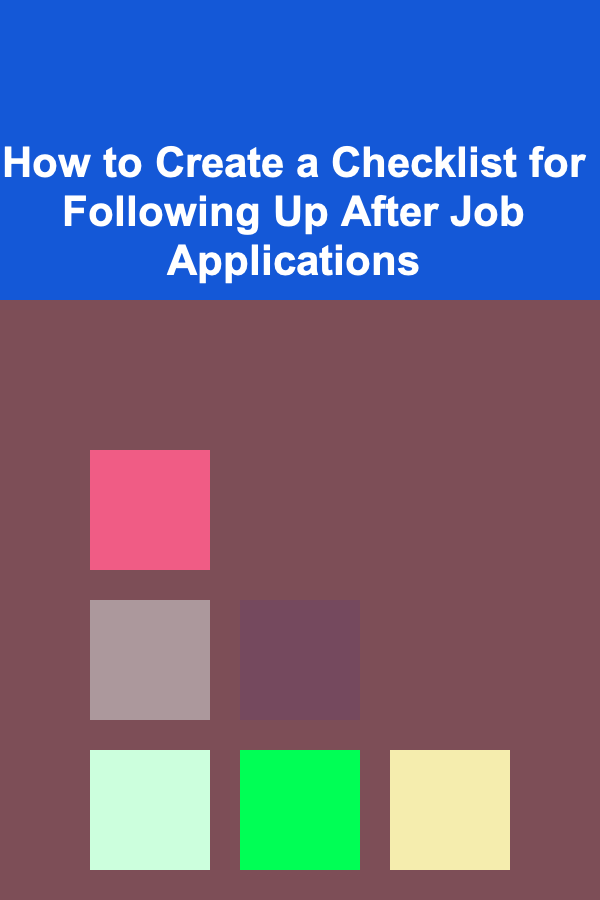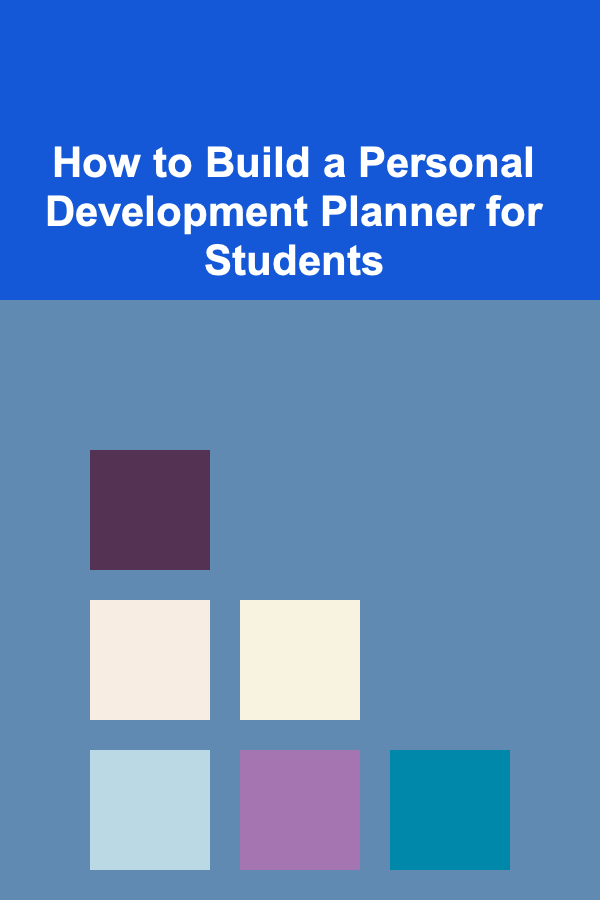
How to Create a Checklist for Following Up After Job Applications
ebook include PDF & Audio bundle (Micro Guide)
$12.99$10.99
Limited Time Offer! Order within the next:

The job application process is often long and nerve-wracking, with many applicants unsure of the next steps once their applications are submitted. While you might feel like you have no control over the situation, following up strategically can significantly increase your chances of securing an interview or getting feedback on your application. Creating a checklist for following up after job applications can help you stay organized, professional, and proactive.
In this guide, we'll walk you through the process of creating an actionable and effective checklist for following up after job applications, ensuring that you maximize your chances of success.
Why Following Up is Important
Before we dive into the specifics of creating a checklist, it's important to understand the role following up plays in the job application process. Here's why it matters:
- Shows Initiative: Following up demonstrates that you're genuinely interested in the position and proactive in your approach. It signals to employers that you're eager to contribute to the organization.
- Keeps You Top of Mind: Hiring managers receive numerous applications for each open position, and it's easy for yours to get lost in the shuffle. A well-timed follow-up email ensures that your name stays on the radar.
- Clarifies Status: A follow-up is an opportunity to clarify where you stand in the hiring process. It gives you insight into whether you're still being considered or if the employer has moved on to other candidates.
- Reflects Professionalism: A polite and professional follow-up helps you stand out as a reliable and courteous candidate. It shows that you understand the importance of maintaining good communication and follow-through.
Now that we know why following up is essential, let's get into how to build an effective checklist.
Creating a Follow-Up Checklist
Creating a checklist will help you streamline the follow-up process and ensure that you don't miss any important steps. Here's a comprehensive approach to building your follow-up strategy:
1. Wait the Appropriate Amount of Time Before Following Up
The first item on your checklist should be deciding how long to wait before following up. You don't want to seem impatient, but you also want to make sure your application doesn't get forgotten.
- General Rule of Thumb : Wait 5-7 business days after submitting your application or after the application deadline has passed before following up.
- After an Interview : If you've already interviewed, it's appropriate to follow up within 24-48 hours to thank the interviewer for their time and express continued interest in the position.
Checklist Tip:
- Set a reminder on your calendar to follow up at the appropriate time, ensuring you don't forget to reach out.
2. Determine Who to Follow Up With
Identifying the right person to contact is crucial. You don't want to send your follow-up to the wrong person, as this may harm your chances of being considered.
- Hiring Manager: In most cases, you'll want to follow up with the hiring manager or the person who posted the job.
- HR Representative: If you're unsure about who to contact, try reaching out to the HR department or the contact listed in the job posting. If you have a recruiter, follow up with them as well.
- Interviewers: If you've already had an interview, it's ideal to follow up with the person who interviewed you.
Checklist Tip:
- Double-check the job listing for contact information. If no name is listed, LinkedIn or the company website can help you identify the right person to contact.
3. Craft a Polite, Professional Follow-Up Email
The heart of your follow-up checklist is crafting a professional, clear, and concise email. Your tone should always be polite, and your message should reflect your interest in the position.
Here's a structure you can follow for your follow-up email:
Subject Line:
- Keep the subject line simple and clear, such as:
- "Follow-up on Job Application for [Position Title]"
- "Checking In on My Application for [Position Title]"
Body:
-
Introduction: Start by thanking the employer for their time and briefly mention the position you applied for.
- Example: "Dear [Hiring Manager's Name], I hope this email finds you well. I wanted to follow up on my application for the [Position Title] role that I submitted on [date]."
-
Reaffirm Interest: Restate your enthusiasm for the position and your belief that you're a great fit for the role.
- Example: "I remain very excited about the opportunity to join [Company Name] and contribute to your team. My background in [mention relevant skills or experiences] makes me confident that I would be a strong addition."
-
Request for Update: Politely inquire about the status of your application.
- Example: "I wanted to inquire if there are any updates regarding my application or the timeline for the next steps in the hiring process. I understand how busy things can get and appreciate any information you can share."
-
Closing: End the email by thanking the hiring manager again and expressing your willingness to provide additional information if necessary.
- Example: "Thank you again for considering my application. If you need any additional materials or information, please don't hesitate to let me know. I look forward to hearing from you."
Checklist Tip:
- Proofread your email for spelling and grammatical errors. A well-written email shows professionalism.
4. Send a Follow-Up Email After Interviews
If you've already had an interview, a follow-up email is not only a great way to express your continued interest, but it also allows you to reiterate why you're the best fit for the role.
Post-Interview Follow-Up Structure:
-
Thank the Interviewer: Always begin with a sincere thank-you note for the time they took to meet with you.
- Example: "Thank you so much for taking the time to meet with me earlier today. I truly enjoyed our conversation about the [Position Title] role and the work your team is doing at [Company Name]."
-
Reaffirm Your Interest: Restate your enthusiasm for the role and how your skills align with the position.
- Example: "Our discussion reinforced my excitement about the position. I am eager to contribute my skills in [mention relevant skill or experience] to help your team achieve [mention a goal or challenge discussed]."
-
Clarify Any Follow-Up Questions: If there was anything that came up during the interview that you'd like to clarify or expand on, use this opportunity.
- Example: "I also wanted to clarify my experience with [specific tool, skill, or process] that I believe would benefit the team in [specific way]."
-
Set a Timeframe for Next Steps: If the interviewer mentioned a timeline for next steps, politely inquire if they're still on track or if there have been any updates.
- Example: "If possible, I'd love to hear more about the next steps in the hiring process as discussed. I remain very interested and am excited about the potential opportunity to join your team."
5. Be Persistent, But Not Pushy
If you don't hear back after your first follow-up, it's okay to send a second email. However, you should always be respectful of the employer's time and avoid bombarding them with multiple follow-ups.
- When to Send a Second Follow-Up: If you haven't heard back after 7-10 business days, it's appropriate to send a polite second follow-up email.
- Avoid Over-Following Up: If you still don't receive a response after your second follow-up, it's best to move on. It may mean that the employer has chosen another candidate or that your application is still under review.
Checklist Tip:
- Limit follow-ups to two attempts. If you don't receive a response after those, it's time to focus on other opportunities.
6. Track Your Applications and Follow-Ups
To stay organized, it's essential to track every job application you submit and the follow-ups associated with each one. Keeping a record will help you manage your time and ensure you're staying on top of deadlines.
- Create a Spreadsheet: List all the jobs you've applied to, along with their respective deadlines, hiring manager contact details, and follow-up dates.
- Use Calendar Reminders: Set calendar reminders to follow up on specific dates, so you don't forget to reach out.
Checklist Tip:
- Use an app or tool that helps you stay organized. Consider using a project management tool, a job search tracking app, or a simple spreadsheet to track your applications and follow-ups.
7. Be Prepared to Take Action Based on Responses
When you get a response, be ready to take the next steps quickly. Whether it's scheduling an interview, providing additional information, or moving on to another opportunity, it's important to act promptly.
Checklist Tip:
- Always respond within 24 hours when you receive a reply, whether it's a request for an interview or feedback on your application.
Conclusion
Creating a checklist for following up after job applications is a powerful tool in your job search arsenal. By being organized, professional, and timely in your follow-ups, you can increase your chances of standing out in a crowded job market.
Remember, persistence is key---but so is patience and respect for the employer's time. With a strategic approach to follow-ups, you'll position yourself as a strong, reliable candidate and significantly improve your odds of landing that next job opportunity.
Reading More From Our Other Websites
- [Personal Care Tips 101] How to Incorporate Toothpaste into Your Daily Oral Hygiene Routine
- [Home Budget 101] How to Save Money on Home Furnishings and Appliances
- [Home Renovating 101] How to Avoid Common Mistakes in a Home Renovation
- [Personal Investment 101] How to Use Economic Indicators to Make Smarter Investment Decisions
- [Home Staging 101] How to Create a Welcoming Entryway for Home Staging
- [Organization Tip 101] How to Utilize Entryway Mats for Organized Shoe Removal
- [Organization Tip 101] How to Declutter Your Mind through Home Organization
- [Sewing Tip 101] Best Techniques for Sewing Heat‑Resistant Protective Clothing for Hobbyists
- [Reading Habit Tip 101] Best Approaches to Blend Language Learning with Your Daily Reading Habit
- [Personal Financial Planning 101] How to Negotiate a Lower Interest Rate on Your Student Loans

The Art of Standing Out: Creative Techniques for Making an Impact
Read More
How To Understand the Elements of Screenwriting
Read More
How to Develop Emotional Intelligence for Career Success
Read More
Dealing with Fearful Behaviors in Dogs: A Comprehensive Guide
Read More
How to Create a Debt Repayment To-Do List When You're Overwhelmed
Read More
How to Build a Personal Development Planner for Students
Read MoreOther Products

The Art of Standing Out: Creative Techniques for Making an Impact
Read More
How To Understand the Elements of Screenwriting
Read More
How to Develop Emotional Intelligence for Career Success
Read More
Dealing with Fearful Behaviors in Dogs: A Comprehensive Guide
Read More
How to Create a Debt Repayment To-Do List When You're Overwhelmed
Read More